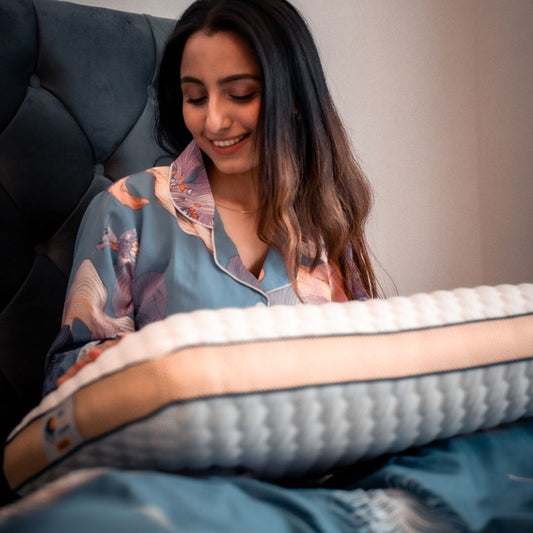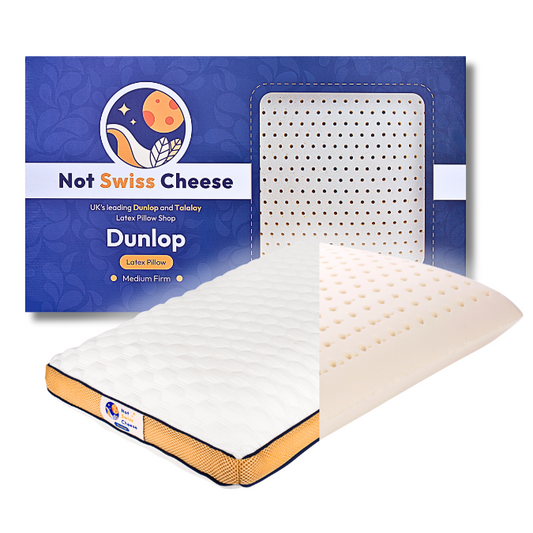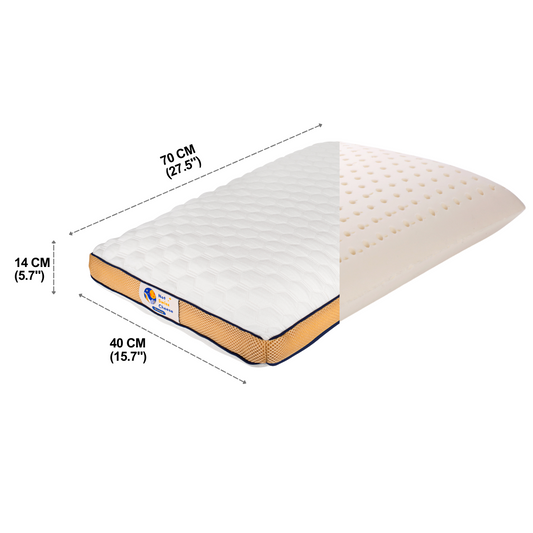Struggling with neck pain? The right pillow can make all the difference. A good pillow keeps your spine aligned, reduces strain, and improves sleep quality. Here’s what you need to know:
-
Sleep Position Matters:
- Back sleepers: Medium-loft pillows (3–5 inches).
- Side sleepers: High-loft pillows (5+ inches).
- Stomach sleepers: Low-loft pillows (under 3 inches).
- Materials to Consider:
-
Key Features:
- Proper height and firmness are essential for spinal alignment.
- Cervical support pillows with ergonomic designs are great for targeted relief.
Quick Tip:
Test your pillow during trial periods (7+ nights) and adjust positioning for best results. Pair the right pillow with good sleep posture to ease neck pain effectively.
The 5 Best Cervical Neck Pillows (Product Guide & Reviews)
How to Pick a Pillow for Neck Pain
Finding the right pillow can make a big difference in reducing neck pain and improving sleep quality. Here’s what to consider.
Sleep Position and Pillow Support
Your preferred sleep position plays a major role in determining the kind of pillow you need for proper neck alignment:
- Back sleepers: A medium-loft pillow (3–5 inches thick) keeps the spine in a neutral position.
- Side sleepers: A higher pillow (around 5 inches) helps keep the head aligned with the shoulders.
- Stomach sleepers: Although this position isn't ideal, a low-loft pillow (under 3 inches) can help reduce neck strain.
Pillow Height and Firmness
Height and firmness are also crucial for maintaining alignment. Here's a quick guide:
| Loft Height | Best For | Recommended Firmness |
|---|---|---|
| Low (< 3") | Stomach sleepers | Soft to medium |
| Medium (3-5") | Back sleepers | Medium to medium-firm |
| High (> 5") | Side sleepers | Medium-firm to firm |
The goal is to keep your ears aligned with your shoulders for a neutral spine. Firmer pillows tend to hold their shape better, but they should still allow for natural neck movement. Once you've identified the right height and firmness, it’s time to think about materials.
Choosing the Right Material
- Offer consistent, responsive support.
- Are breathable and long-lasting.
- Naturally resist allergens.
- Mold to the shape of your neck and head.
- Distribute weight evenly for stable support.
- Can retain more heat compared to latex.
For example, Not Swiss Cheese offers Talalay latex pillows that provide soft, supportive comfort, great for those new to specialized pillows [2][4]. Their Dunlop latex options are firmer, perfect for those with severe neck pain or active lifestyles.
The best pillow for neck pain combines the right height, firmness, and material to ensure proper spinal alignment and long-lasting comfort. Take the time to find the right match for your needs, and you'll feel the difference every night.
Best Pillow Types for Neck Pain
Finding the right pillow can make a big difference when it comes to easing neck pain. Certain types are designed to provide the support and comfort needed for better sleep and relief. Here’s a closer look at some top options.
Latex Pillows
Latex pillows are known for their consistent support and ability to keep their shape over time. They come in two main types:
- Talalay Latex: Softer and more plush, making it a great choice for those new to latex pillows.
- Dunlop Latex: Firmer and more supportive, ideal for people with severe neck pain or active lifestyles.
Both types are naturally breathable and resistant to allergens, making them a healthy and durable option. Brands like Not Swiss Cheese offer eco-friendly latex pillows designed to promote spinal alignment and long-lasting comfort. Plus, they help regulate temperature for a cooler night's sleep.
If latex doesn’t suit your needs, memory foam pillows offer an alternative with a focus on contouring and pressure relief.
Memory Foam Pillows
Memory foam pillows are popular for their ability to mold to the shape of your head and neck, providing targeted support. They come in two main styles:
-
Solid Memory Foam
Offers precise contouring and consistent support throughout the night. -
Shredded Memory Foam
Provides adjustable support and better airflow, making it easier to adapt to position changes.
"Memory foam pillows offer great body-contouring. This means they'll form to the contours of your head and neck to evenly distribute your weight and relieve pressure." - Sleepopolis Team [1]
For those who need even more specific neck alignment, cervical support pillows are worth considering.
Cervical Support Pillows
Cervical support pillows are designed with ergonomic shapes to keep your neck and spine properly aligned. These pillows often feature:
- A contoured design to support the natural curve of the neck.
- Elevated sides for side sleepers to maintain alignment.
- A central depression to cradle the head, suitable for various sleep positions.
When choosing a cervical pillow, think about your primary sleep position. Back sleepers usually prefer medium-height options, while side sleepers may need slightly higher pillows to keep their necks aligned.
Selecting the right pillow can make all the difference in managing neck pain and improving your overall sleep quality.
sbb-itb-7fb8e9c
Getting the Most from Your Pillow
Once you've chosen a pillow designed to ease neck pain, it's important to use it effectively. Here's how to make the most of it.
Return Policy Tips
When buying a pillow, keep these points in mind:
- Look for trial periods lasting at least 7 nights, with return windows of 30–50 nights to give you enough time to test it.
- Ensure the return process is straightforward.
- Review warranty terms to understand what’s covered.
Proper Pillow Positioning
Even the best pillow won’t work if it’s not positioned correctly. Here’s how to align it based on your sleep style:
Back Sleepers
- Use a pillow with a low profile and place a rolled towel under your neck for extra support.
- Keep your chin in a neutral position.
Side Sleepers
- Pick a taller pillow that keeps your neck aligned with your spine. Position it close to your shoulders.
- Make sure your ear stays in line with your shoulder.
Stomach Sleepers
- Go for an ultra-thin pillow or skip it entirely.
- Place a flat pillow under your hips to reduce strain on your neck.
How to Tell If Your Pillow Is Working
You’ll know your pillow is doing its job if you notice these changes:
- Physical Relief: Less neck stiffness and pain, improved mobility, and no tingling or numbness in your arms.
- Better Sleep: Fewer tosses and turns, and waking up feeling rested.
- Posture Changes: Improved neck alignment, reduced shoulder tension, and better spinal posture.
"Proper spinal alignment and support during sleep are crucial for neck pain relief. When you find the right pillow and position it correctly, you should notice improvements in both pain levels and sleep quality within a few nights." [3]
If you’re not seeing results in a few days, try adjusting your pillow position or consider testing another option during your trial period. Pairing the right pillow with good sleep posture and other care routines can further boost neck pain relief.
Extra Steps for Neck Pain Relief
In addition to selecting the right pillow, there are other ways to ease neck discomfort, both while sleeping and during the day.
Sleep Posture Tips
The way you sleep plays a big role in neck pain. Sleeping on your back is often the best option for keeping your spine aligned. On the other hand, sleeping on your stomach can strain your neck due to forced rotation.
Here’s how to support your neck based on your sleeping position:
Back Sleepers
- Place your pillow so it supports your shoulders slightly, add a small rolled towel under your neck, and keep your chin in a neutral position.
Side Sleepers
- Use a pillow that fills the space between your head and shoulders, align your neck with your spine, and consider putting a pillow between your knees for extra support.
While adjusting your sleep posture can help, some situations may need professional attention.
Medical Care Guidelines
If changing your pillow and sleep habits doesn’t ease your neck pain, it might be time to consult a doctor. Seek medical advice if you experience:
- Pain that doesn’t go away despite posture adjustments
- Numbness or tingling in your arms or legs
- Difficulty moving your neck
- Pain combined with fever or chills
- Neck pain after an injury or trauma
For managing ongoing neck pain, try these approaches:
Daily Exercises
- Gentle neck stretches
- Shoulder rolls
- Physical therapy for more severe cases
Lifestyle Adjustments
- Practice good posture throughout the day
- Set up an ergonomic workspace with your monitor at eye level
- Take regular breaks to stretch and move around
Summary
Choosing the right pillow height and material plays a key role in keeping your spine aligned and easing neck pain. The best pillow for you depends on your sleep position, ensuring proper support and comfort all night long.
Natural latex pillows stand out for their durability and eco-friendly nature. Talalay latex offers a softer feel, while Dunlop latex provides a firmer option, catering to varying preferences. Memory foam pillows are another solid choice, offering support through their ability to contour to your head and neck [3].
- Back sleepers: Medium-loft pillows work best.
- Side sleepers: Opt for higher-loft pillows for proper support.
- Stomach sleepers: Low-loft pillows are ideal to maintain alignment.
Keeping your spine in the right position can help reduce strain and alleviate neck pain over time [3].
To ensure your pillow remains effective, focus on proper care and positioning. High-quality materials like latex and memory foam hold their shape well and provide consistent support, improving both sleep quality and neck comfort [4].
For the best results, pair your pillow choice with the sleep posture tips and lifestyle adjustments mentioned earlier. Selecting a pillow that matches your sleep position and personal needs can make a big difference in your overall sleep experience and neck health.
Still unsure about the right pillow for you? Check out the FAQs below for answers to common questions about picking a pillow for neck pain.
FAQs
What type of pillow works best for neck pain?
Cervical pillows are a great choice for neck pain. They provide targeted support to help keep your spine in a neutral position while you sleep, reducing discomfort [3].
Are latex pillows good for back pain?
Yes, latex pillows are a solid option for back pain relief. They offer consistent support and help with spinal alignment. Not Swiss Cheese's latex pillows, for example, come in different firmness levels, like medium-firm Dunlop and softer Talalay, to cater to various preferences [2][4].
Should I use a flat or high pillow for neck pain?
Flatter pillows are usually better for neck pain because they help avoid excess pressure and keep your head and spine aligned. High pillows can cause misalignment and increase strain on your neck [3]. The key is finding a pillow that keeps your head in a neutral position.
How do I choose the right pillow height?
The ideal pillow height typically falls between 4 to 7 inches, but it depends on a few factors:
- Sleep position: Side sleepers need more height than back sleepers.
- Body frame: Broader shoulders may require a taller pillow for proper alignment.
- Mattress firmness: Softer mattresses might need slightly higher pillows to ensure support.
Your pillow should support your neck’s natural curve and keep your head neutral. If you feel discomfort, adjust the height accordingly [3].
These answers can guide you in selecting the right pillow to ease neck pain and improve sleep quality.








